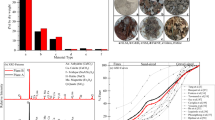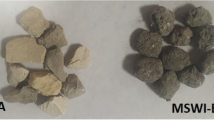Abstract
The main factors driving the reuse of construction waste in pavement are the rapid decline in the availability of conventional aggregates, increasing haulage distances, and the scarcity of landfill sites. Municipal Solid Waste Incineration (MSWI) is a popular solid waste treatment method that can reduce landfill clogging. In an attempt to reduce waste accumulation and conserve natural resources, this study evaluated the effectiveness and feasibility of using MSWI-BA as a partial replacement for fine aggregate in Bitumen Concrete Grade II (BC-II), a closely graded wearing course widely used in India. The optimal asphalt content of asphalt mixes for different MSWI-BA percentages was determined using the Marshall mix design. Tests to determine the resilient modulus, indirect tensile strength, resistance to moisture-induced damage, and rut resistance using a dynamic creep test were conducted to study the performance of the asphalt mixes with various MSWI-BA contents. From the research, it is advisable to replace the fine aggregates with MSWI-BA up to 20% to obtain a physically strong, higher performing, and economically efficient bituminous concrete layer. The toxicity characteristic leaching procedure test results indicated that the concentration of heavy metals and the levels of toxicity were significantly reduced after it was mixed with asphalt mix.











Similar content being viewed by others
Data availability
Data will be made available on reasonable request.
References
Kumar S (2016) Municipal Solid Waste Management in Developing Countries. CRC Press, Boca Raton. https://doi.org/10.1201/9781315369457
Ahluwalia, I, J. Patel, U. (2018), Solid Waste Management in India An Assessment of Resource Recovery and Environmental Impact, Indian Council For Research On International Economic Relations. https://icrier.org/pdf/Working_Paper_356.pdf
Joshi, R. and Ahmed, S. (2016). Status and challenges of municipal solid waste management in india: a review Cogent Environmental Science https://doi.org/10.1080/23311843.2016.1139434
A, K, Mandal., O, P, Sinha., (2014). Review on Current Research Status on Bottom Ash: An Indian Prospective, The Institution of Engineers (India) Ser. A (October–December 2014) 95(4):277–297. DOI: https://doi.org/10.1007/s40030-014-0100-0
Bagchi A, Sopcich D (1989) Characterization Of M S W Incinerator Ash. J Environ Eng. https://doi.org/10.1061/(ASCE)0733-9372(1989)115:2(447)
P. Colonna, N. Berloco, V. Ranieri, S.T. Shuler. (2012). Application of Bottom Ash for Pavement Binder Course, SIIV - 5th International Congress - Sustainability of Road Infrastructures. DOI: https://doi.org/10.1016/j.sbspro.2012.09.945
Churchill EV, Amirkhanian SN (1999) Coal ash utilization in asphalt concrete mixtures. J Mater Civ Eng. https://doi.org/10.1061/(ASCE)0899-1561(1999)11:4(295)
Goh SW, You Z (2008) A preliminary study of the mechanical properties of asphalt mixture containing bottom ash. Can J Civ Eng. https://doi.org/10.1139/L08-071
Vasudevan G (2013) Performance on coal bottom ash in hot mix asphalt. Int J Eng Res Technol. https://doi.org/10.15623/ijret.2013.0208004
Forteza R, Far M, Segu C, Cerda V (2004) Characterization of bottom ash in municipal solid waste incinerators for its use in road base. Waste Manage 24(2004):899–909. https://doi.org/10.1016/j.wasman.2004.07.004
Khaled Ksaibati, Shiva Rama Krishna Sayiri, (2016), Utilization of Wyoming Bottom Ash in Asphalt Mixes, Department of Civil & Architectural Engineering, University of Wyoming. Utilization of Wyoming Bottom Ash in Asphalt Mixes (MPC-06–179) (ugpti.org)
Lynn C, Ghataora G, Dhir R (2016) Municipal Incinerated Bottom Ash (MIBA) characteristics and potential for use in road pavements. Int J Pavement Res Technol. https://doi.org/10.1016/j.ijprt.2016.12.003
Ogunro VO, Inyang HI, Hooper F, Young D, Oturkar A (2004) Gradation control of bottom ash aggregate in superpave bituminous mixes. J Mater Civ Eng 16(6):604–613. https://doi.org/10.1061/(ASCE)0899-1561(2004)16:6(604)
Yan K, Li L, Long Z, Xiao L, Liu K, Zhou W, You L, Ou J, Wu S (2022) Conversion of municipal solid waste incineration bottom ash in asphalt pavements. Adv. Civ Eng. Mater. 11:20210032. https://doi.org/10.1520/ACEM20210032
Peng-Fei F, Xiang-Rong Z, Hong-Shui C, Wei C (2010) Engineering characteristics of bottom ash in municipal solid waste incinerators. J Geotech Geoenvironmental Eng –ASCE. https://doi.org/10.1061/41105(378)14
Ministry of Road Transport and Highways. (2013). Specifications for Road and Bridge Works, (Fifth Revision). New Delhi.
ASTM D 36 – 14. (2019). Standard Test Method for Softening Point of Bitumen (Ring-and-Ball Apparatus)
ASTM D 113 – 17 (2017). Standard Test Method for Ductility of Asphalt Materials.
ASTM D5M-20 (2020). Standard Test Method for Penetration of Bituminous Materials.
ASTM D70–21 (2021). Standard Test Method for Specific Gravity and Density of Semi-Solid Asphalt Binder (Pycnometer Method).
ASTM D4402–06. (2006). Standard Test Method for Viscosity Determination of Asphalt at Elevated Temperatures Using a Rotational Viscometer. Annual Book of ASTM Standards, 1–4
ASTM C 127 – 15 (2015). Standard Test Method for Relative Density (Specific Gravity) and Absorption of Coarse Aggregate
IS 2386–1 (1963): Methods of Test for Aggregates for Concrete, Part I: Particle Size and Shape [CED 2: Cement and Concrete]." Bureau of Indian Standards.
IS 2386–4 (1963): Methods of test for aggregates for concrete, Part 4: Mechanical properties [CED 2: Cement and Concrete]." Bureau of Indian Standards.
ASTM C 131M-20 (2020). Standard Test Method for Resistance to Degradation of Small-Size Coarse Aggregate by Abrasion and Impact in the Los Angeles Machine.
Gupta G, Datta M, Ramana GV, Alappat BJ (2021) MSW Incineration Bottom Ash (MIBA) as a substitute to conventional materials in geotechnical applications: a characterization study from India and comparison with literature. Constr Build Mater. https://doi.org/10.1016/j.conbuildmat.2021.124925
ASTM C 128 – 15 (2015). Standard Test Method for Relative Density (Specific Gravity) and Absorption of Fine Aggregate.
AASHTO T 90 - 16 (2016). Standard Method of Test for Determining the Plastic Limit and Plasticity Index of Soils.
ASTM D1557–12 (2021).Standard Test Methods for Laboratory Compaction Characteristics of Soil Using Modified Effort.
ASTM D1883–21 (2021). Standard Test Method for California Bearing Ratio (CBR) of laboratory-compacted soils.
ASTM D2434–22 (2022). Standard test methods for measurement of hydraulic conductivity of coarse-grained soils.
IS-2720 (PART 4)-1985-Indian standard methods of test for soils grain size analysis (Second Revision)." Bureau of Indian Standards.
Asphalt Institute MS-2 7th Edition. (2015). https://www.studocu.com/in/document/indian-institute-of-science/chemical-reaction-engineering/asphalt-institute-ms2-7th-edition-asphalt-institute-mix-design/17979300
ASTM D 6927–15. (2015). Standard Test Method for Marshall Stability and Flow of Bituminous Mixtures. Annual Book of American Society for Testing materiasl ASTM Standards, 1–7.
ASTM: D 2726–19. (2019). Standard Test Method for Bulk Specific Gravity and Density of Non-Absorptive Compacted Asphalt Mixtures.
ASTM: D 2041–03a. (2003). Standard test method for theoretical maximum specific gravity and density of bituminous paving mixtures. ASTM International, 1–7.
AASHTO T 283. (2022). Standard method of test for resistance of compacted asphalt mixtures to moisture-induced damage
ASTM D6931–17. (2017). Standard Test Method for Indirect Tensile Strength of Bituminous Mixtures.
ASTM D 4123 – 82 (Reapproved 1995). () Standard Test Method for Indirect Tension Test for Resilient Modulus of Bituminous Mixtures.
EN 12697–25, (2005), Bituminous mixtures - Test methods for hot mix asphalt - Part 25: Cyclic compression test.
IRC:37–2018. Guidelines for. the design of flexible pavements. {Fourth revision). Indian roads congress. 2018.
Epa US (1990) Test Methods for Evaluating Solid Waste Method 1311. US EPA, Washington DC
Hazardous and other Wastes (Management & Transboundary Movement) Rules, 2016, GOVERNMENT OF INDIA MINISTRY OF ENVIRONMENT, FOREST AND CLIMATE CHANGE NOTIFICATION." Ministry of Environment, Forest and Climate Change, Government of India.
Sawada K, Matsuda H, Mizutani M (2001) Immobilizatoin of lead compounds in fly ash by mixing with asphalt sulfur and sodium hydroxide. J Chem Eng Jpn. https://doi.org/10.1252/jcej.34.878
Acknowledgements
The authors would like to acknowledge the Principal Scientific Advisor (PSA), Government of India and IIT-Delhi for funding the project to CSIR-CRRI under Delhi Cluster-“Delhi Research Implementation and Innovation” (DRIIV), Theme Solid Waste Management, WP-6 Use of construction & demolition wastes, incinerated residues in road construction scheme.
Funding
Principal Scientific Adviser to the Government of India.
Author information
Authors and Affiliations
Corresponding author
Additional information
Publisher's Note
Springer Nature remains neutral with regard to jurisdictional claims in published maps and institutional affiliations.
Rights and permissions
Springer Nature or its licensor (e.g. a society or other partner) holds exclusive rights to this article under a publishing agreement with the author(s) or other rightsholder(s); author self-archiving of the accepted manuscript version of this article is solely governed by the terms of such publishing agreement and applicable law.
About this article
Cite this article
Gowda, S., Kunjar, V., Gupta, A. et al. Municipal incinerated solid waste bottom ash as sustainable construction material in the construction of flexible pavements. J Mater Cycles Waste Manag 25, 3824–3833 (2023). https://doi.org/10.1007/s10163-023-01809-2
Received:
Accepted:
Published:
Issue Date:
DOI: https://doi.org/10.1007/s10163-023-01809-2




